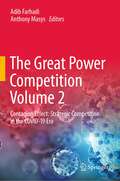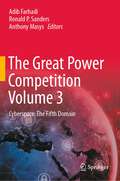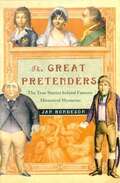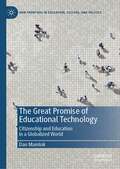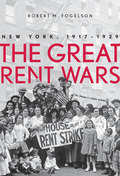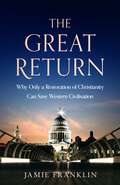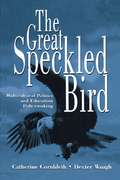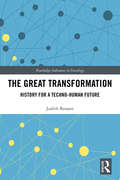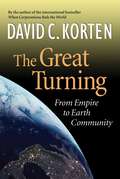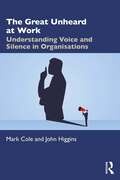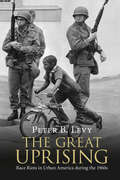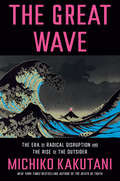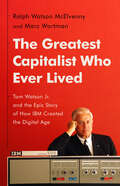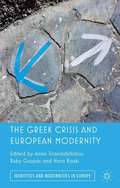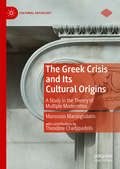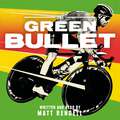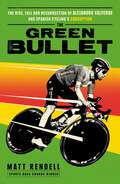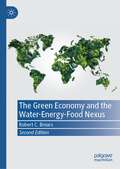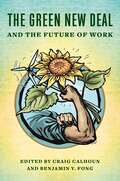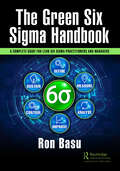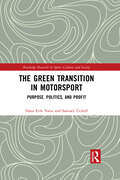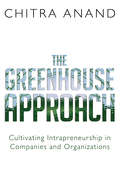- Table View
- List View
The Great Power Competition Volume 2: Contagion Effect: Strategic Competition in the COVID-19 Era
by Anthony Masys Adib FarhadiEven before the outbreak of the COVID-19 pandemic, the Central Region faced numerous obstacles to building a stable and prosperous future. The region, which encompasses the Middle East, the Horn of Africa, Central Asia, and South Asia, has been plagued by economic and political uncertainty amidst dramatic shifts in the global power structure. With the pandemic now exacerbating the volatility in this already fragile region, the U.S.'s strategic objectives are rife for re-examination.A complicated stew of factors such as weakening of established governance systems, the emboldening of extremist individuals and groups through advances in digital technology, the humanitarian crises in Afghanistan and Syria, and the intensification of the great power competition with China and Russia are creating a fertile environment for the growth of violent extremist organizations (VEOs). Such organizations take advantage of vulnerable, aggrieved, and traumatized populations to fuel radicalization, recruitment, and unrest, which further undermine stability and the potential for peace and prosperity.While it is still early to fully understand how the ongoing response to the COVID-19 pandemic will impact U.S. policy, this book provides a timely analysis of relevant dynamics such as popular radicalization, digital information ecosystems, networks of influence, and new capabilities to recognize and prepare for other such black swan events in the region.
The Great Power Competition Volume 3: Cyberspace: The Fifth Domain
by Ronald P. Sanders Anthony Masys Adib FarhadiFor millennia, humans waged war on land and sea. The 20th century opened the skies and the stars, introducing air and space as warfare domains. Now, the 21st century has revealed perhaps the most insidious domain of all: cyberspace, the fifth domain. A realm free of physical boundaries, cyberspace lies at the intersection of technology and psychology, where one cannot see one’s enemy, and the most potent weapon is information.The third book in the Great Power Competition series, Cyberspace: The Fifth Domain, explores the emergence of cyberspace as a vector for espionage, sabotage, crime, and war. It examines how cyberspace rapidly evolved from a novelty to a weapon capable of influencing global economics and overthrowing regimes, wielded by nation-states and religious ideologies to stunning effect.Cyberspace: The Fifth Domain offers a candid look at the United States’ role in cyberspace, offering realistic prescriptions for responding to international cyber threats on the tactical, strategic, and doctrinal levels, answering the questions of how can we respond to these threats versus how should we respond? What are the obstacles to and consequences of strategic and tactical response options? What technological solutions are on the horizon? Should the U.S. adopt a more multi-domain offensive posture that eschews the dominant “cyber vs. cyber” paradigm? To answer these questions, experts examine the technological threats to critical infrastructure; cyber operations strategy, tactics, and doctrine; information influence operations; the weaponization of social media; and much more.
The Great Pretenders: True Stories Behind Famous Historical Mysteries
by Jan BondesonJAN BONDESON, M.D. focuses his medical expertise and his inciteful wit on the great unsolved mysteries of disputed identity of the last two hundred years. Did the son of Louis Xvi and Marie Antoinette die during his imprisonment in the Temple Tower, or was he one of the people claiming to be the Lost Dauphin after the Terror ended? What does DNA testing on the heart proported to belong to the Dauphin reveal? Was Kaspar Hauser, the mysterious boy who claimed to have spent his entire childhood in a subterranean dungeon, really the Crown Prince of Baden, or was he suffering from pseudologia fantastica, a pathological desire to deceive other people? And when an eccentric and reclusive duke built a complete set of tunnels and rooms beneath his country estate, who is to say that he also didn't have a second life as a shopkeeper with a separate family in London? In this highly anticipated work covering the most famous unsolved cases of disputed identity, Jan Bondeson uncovers all the evidence, then applies his medical knowledge and logical thinking to ascertain the true stories behind these fascinating histories. JAN bondeson, M.D., professor at University of Wales College of Medicine, Cardiff, is the author of Buried Alive, A Cabinet of Medical Curiosities, The Feejee Mermaid, The Two-Headed Boy, and The London Monster, among other works.
The Great Promise of Educational Technology: Citizenship and Education in a Globalized World (New Frontiers in Education, Culture, and Politics)
by Dan MamlokThis book critically looks at the tensions between the promise to transform education through the use of digital technology and the tendency to utilize digital technology in instrumental and technical ways. The widespread use of digital technology has had a remarkable effect on almost every domain of human life. This technological change has caused governments, educational departments, and non-governmental organizations (NGOs) to recognize the need to develop educational plans that would support the social and the cultural changes that have occurred with the ubiquitous permeation of digital technology into our everyday lives. This book challenges common assumptions regarding digital technology and education, through critical exploration of educational policies, interviews, and class observations in the US and Israel. In doing so, the author sheds light on the possibilities of advancing digital citizenship under current educational policies.
The Great Rent Wars
by Robert M. FogelsonWritten by one of the country’s foremost urban historians, The Great Rent Wars tells the fascinating but little-known story of the battles between landlords and tenants in the nation’s largest city from 1917 through 1929. These conflicts were triggered by the post-war housing shortage, which prompted landlords to raise rents, drove tenants to go on rent strikes, and spurred the state legislature, a conservative body dominated by upstate Republicans, to impose rent control in New York, a radical and unprecedented step that transformed landlord-tenant relations. The Great Rent Wars traces the tumultuous history of rent control in New York from its inception to its expiration as it unfolded in New York, Albany, and Washington, D. C. At the heart of this story are such memorable figures as Al Smith, Fiorello H. La Guardia, and Oliver Wendell Holmes, as well as a host of tenants, landlords, judges, and politicians who have long been forgotten. Fogelson also explores the heated debates over landlord-tenant law, housing policy, and other issues that are as controversial today as they were a century ago.
The Great Return
by Jamie FranklinThe decline in Secular Western morality can only be halted and reversed by a full return to Christianity.Many people have a sense that the Western World is in decline and that our society is fragmenting around us. Many people have an ominous sense that we are living at the end of a civilised age and are moving into something far less pleasant and humane. But fewer people understand why this is happening. In this new book, Jamie Franklin argues that the reason for this decline is because we have jettisoned the underlying belief system that gave birth to the Western world - and the Western mind - in the first place: Christianity. He argues that there is a logical and inevitable link between the decline of Christianity and the decline of the West. As our metaphysical commitment to Christianity declines, so does our commitment to the benefits that came to us from Christianity. Through captivating argument, he demonstrates how this plays out in the scientific realm, which has abandoned objectivity for dogmatism; in the ethical realm, which is eliminating humanity from its own formulations; and in the political scene, as it moves away from the democratic principle towards a neo-marxist influenced, nihilistic technocracy that threatens to eliminate human culture, distinctiveness and agency in the pursuit of a globalist utopia. In so doing, Franklin touches on contemporary political conversations that are exercising the public imagination such as abortion, euthanasia, transhumanism, and the rebirth of the totalitarian impulse in Western democracies. Only a revival of Christianity can reverse these trends. This book urges the Church to take seriously its own commitment to the metaphysical and ethical presuppositions of its own faith. But also acknowledges the great challenge that Christianity faces as it threatens to be overwhelmed by the rising tide of secular nihilism that may yet engulf the Western World.
The Great Return
by Jamie FranklinThe decline in Secular Western morality can only be halted and reversed by a full return to Christianity.Many people have a sense that the Western World is in decline and that our society is fragmenting around us. Many people have an ominous sense that we are living at the end of a civilised age and are moving into something far less pleasant and humane. But fewer people understand why this is happening. In this new book, Jamie Franklin argues that the reason for this decline is because we have jettisoned the underlying belief system that gave birth to the Western world - and the Western mind - in the first place: Christianity. He argues that there is a logical and inevitable link between the decline of Christianity and the decline of the West. As our metaphysical commitment to Christianity declines, so does our commitment to the benefits that came to us from Christianity. Through captivating argument, he demonstrates how this plays out in the scientific realm, which has abandoned objectivity for dogmatism; in the ethical realm, which is eliminating humanity from its own formulations; and in the political scene, as it moves away from the democratic principle towards a neo-marxist influenced, nihilistic technocracy that threatens to eliminate human culture, distinctiveness and agency in the pursuit of a globalist utopia. In so doing, Franklin touches on contemporary political conversations that are exercising the public imagination such as abortion, euthanasia, transhumanism, and the rebirth of the totalitarian impulse in Western democracies. Only a revival of Christianity can reverse these trends. This book urges the Church to take seriously its own commitment to the metaphysical and ethical presuppositions of its own faith. But also acknowledges the great challenge that Christianity faces as it threatens to be overwhelmed by the rising tide of secular nihilism that may yet engulf the Western World.
The Great Speckled Bird: Multicultural Politics and Education Policymaking
by Catherine Cornbleth Dexter WaughThis unique volume takes readers behind the scenes for an "insider/outsider" view of education policymaking in action. Two state-level case studies of social studies curriculum reform and textbook policy (California and New York) illustrate how curriculum decision making becomes an arena in which battles are fought over national values and priorities. Written by a New York education professor and a California journalist, the text offers a rare blend of academic and journalistic voices. The "great speckled bird" is the authors' counter-symbol to the bald eagle--a metaphor representing the racial-ethnic-cultural diversity that has characterized the U.S. since its beginnings and the multicultural reality of American society today. The text breaks new ground by focusing on the intersections of national debates and education policymaking. It situates the case studies within historical and contemporary cultural contexts--with particular attention to questions of power and knowledge control and how influence is exercised. By juxtaposing the contrasting cases of California and New York, the authors illustrate commonalities and differences in education policymaking goals and processes. By sharing stories of participants at and behind the scenes, policymaking comes alive rather than appearing to result from impersonal "forces" or "factors."
The Great Transformation: History for a Techno-Human Future (Routledge Advances in Sociology)
by Judith BessantWhile artificial intelligence (AI), robots, bio-technologies and digital media are transforming work, culture, and social life, there is little understanding of or agreement about the scope and significance of this change. This new interpretation of the ‘great transformation’ uses history and evolutionary theory to highlight the momentous shift in human consciousness taking place. Only by learning from recent crises and rejecting technological determinism will governments and communities redesign social arrangements that ensure we all benefit from the new and emerging technologies. The book documents the transformations under way in financial markets, entertainment, and medicine, affecting all aspects of work and social life. It draws on historical sociology and co-evolutionary theory arguing that the radical evolution of human consciousness and social life now under way is comparable with, if not greater than, the agrarian revolution (10000 BCE), the explosion of science, philosophy, and religion in the Axial Age (600 BCE), and the recent Industrial Revolution. Turning to recent major socio-economic crisis, and asking what can be learnt from them, the answer is we cannot afford this time around to repeat the failures of elites and theoretical systems such as economics to attend appropriately to radical change. We need to think beyond the constraints of determinist and reductionist explanations and embrace the idea of deep freedom. This book will appeal to educators, social scientists, policy-makers, business leaders, and students. It concludes with social design principles that can inform deliberative processes and new social arrangements that ensure everyone benefits from the affordances of the new and emerging technologies.
The Great Transition
by Bruce CampbellIn the fourteenth century the Old World witnessed a series of profound and abrupt changes in the trajectory of long-established historical trends. Transcontinental networks of exchange fractured and an era of economic contraction and demographic decline dawned from which Latin Christendom would not begin to emerge until its voyages of discovery at the end of the fifteenth century. In a major new study of this 'Great Transition', Bruce Campbell assesses the contributions of commercial recession, war, climate change, and eruption of the Black Death to a far-reaching reversal of fortunes from which no part of Eurasia was spared. The book synthesises a wealth of new historical, palaeo-ecological and biological evidence, including estimates of national income, reconstructions of past climates, and genetic analysis of DNA extracted from the teeth of plague victims, to provide a fresh account of the creation, collapse and realignment of Western Europe's late medieval commercial economy.
The Great Turning: From Empire to Earth Community (Bk. Currents Ser.)
by David C. KortenDavid Korten’s classic bestseller When Corporations Rule the World was one of the first books to articulate the destructive and oppressive nature of the global corporate economy. In The Great Turning he argues that corporate consolidation of power is merely one manifestation of what he calls “Empire”: the organization of society through hierarchy and violence that has largely held sway for the past 5,000 years. The Great Turning traces the evolution of Empire from ancient times to the present day but also tells the parallel story of the attempt to develop a democratic alternative to Empire, beginning in Athens and continuing with the founding of the United States of America—although elitists with an imperial agenda have consistently sought to undermine the bold and inspiring “American experiment.” Finally, Korten draws on evidence from sources as varied as evolutionary theory, developmental psychology, and religious teachings to make the case that “Earth Community”—a life-centered, egalitarian, sustainable alternative to Empire based on democratic principles of partnership—is indeed possible. And he outlines a grassroots strategy for beginning the momentous turning toward a future of as-yet-unrealized human potential.
The Great Unheard at Work: Understanding Voice and Silence in Organisations
by John Higgins Mark ColeSilence always has something to say – it’s never neutral and speaks volumes if people are willing to hear. Our response to silence is often to dismiss or end it, to block it out with noise. Instead, silence needs to be taken seriously. This book explores the importance of understanding silence and shows how we can move from merely listening to truly hearing those around us. The interplay of voice and silence in organisational life is not straightforward. We can feel pressured to speak and compelled to keep our silence. Knowing how to read silence, to make sense of its generative and degenerative capacity, is a rarely developed skill among managers and leaders at all levels – who have been brought up to see silence as evidence of compliance or a weakness to be addressed. But it is a critical skill for managers and employees alike. Written by two experts in organisational development, this book explores different types of silence and their implications for organisational practice, digging into the theoretical roots and engaging with real stories and voices. It provides everyone at work with an understanding of the different meanings of silence and how to engage well with it. When to stay with it, when to join in with it, and when to be struck by what’s not being said and do something about it. The Great Unheard at Work is essential reading for corporate leaders, HR professionals in all sectors, business students, professionals, and anyone interested in leadership development.
The Great Uprising: Race Riots in Urban America during the 1960s
by Peter B. LevyBetween 1963 and 1972 America experienced over 750 urban revolts. Considered collectively, they comprise what Peter Levy terms a 'Great Uprising'. Levy examines these uprisings over the arc of the entire decade, in various cities across America. He challenges both conservative and liberal interpretations, emphasizing that these riots must be placed within historical context to be properly understood. By focusing on three specific cities as case studies - Cambridge and Baltimore, Maryland, and York, Pennsylvania - Levy demonstrates the impact which these uprisings had on millions of ordinary Americans. He shows how conservatives profited politically by constructing a misleading narrative of their causes, and also suggests that the riots did not represent a sharp break or rupture from the civil rights movement. Finally, Levy presents a cautionary tale by challenging us to consider if the conditions that produced this 'Great Uprising' are still predominant in American culture today.
The Great Wave: The Era of Radical Disruption and the Rise of the Outsider
by Michiko KakutaniAn urgent examination of how disruptive politics, technology, and art are capsizing old assumptions in a great wave of change breaking over today&’s world, creating both opportunity and peril—from the Pulitzer Prize–winning critic and author of the New York Times bestseller The Death of Truth. &“In this dazzling and brilliant book, Michiko Kakutani explains the cascading chaos of our era and points to ways that we can regain some stability.&”—Walter Isaacson, author of Elon MuskThe twenty-first century is experiencing a watershed moment defined by chaos and uncertainty, as one emergency cascades into another, underscoring the larger dynamics of change that are fueling instability across the world. Since the global financial crisis of 2008, people have increasingly lost trust in institutions and elites, while seizing upon new digital tools to sidestep traditional gatekeepers. As a result, powerful new voices—once regarded as radical, unorthodox, or marginal—are disrupting the status quo in politics, business, and culture. Meanwhile, social and economic inequalities are stoking populist rage across the world, toxic partisanship is undermining democratic ideals, and the internet and AI have become high-speed vectors for the spread of misinformation. Writing with a critic&’s understanding of cultural trends and a journalist&’s eye for historical detail, Michiko Kakutani looks at the consequences of these new asymmetries of power. She maps the migration of ideas from the margins to the mainstream and explores the growing influence of outsiders—those who have sown chaos and fear (like Donald Trump), and those who have provided inspirational leadership (like Ukraine&’s president Volodymyr Zelensky). At the same time, she situates today&’s multiplying crises in context with those that defined earlier hinge moments in history, from the waning of the Middle Ages to the transition between the Gilded Age and the Progressive Era at the end of the nineteenth century. Kakutani argues that today&’s crises are not only signs of an interconnected globe&’s profound vulnerabilities, but also stress tests pointing to the essential changes needed to survive this tumultuous era and build a more sustainable future.
The Greatest Capitalist Who Ever Lived: Tom Watson Jr. and the Epic Story of How IBM Created the Digital Age
by Marc Wortman Ralph Watson McElvennyThe enduring story of Thomas Watson Jr.—a figure more important to the creation of the modern world than Rockefeller, Vanderbilt, and Morgan Nearly fifty years into IBM&’s existence, Thomas Watson Jr. undertook the biggest gamble in business history when he &“bet the farm&” on the creation of the IBM System/360, the world&’s first fully integrated and compatible mainframe computer. As CEO, Watson drove a revolution no other company—then or now—would dare, laying the foundation for the digital age that has transformed every society, corporation, and government. The story of Watson being &“present at the creation&” of the digital age is intertwined with near-Shakespearean personal drama. While he put IBM and its employees at risk, Watson also carried out a family-shattering battle over the future of the company with his brother Dick. This titanic struggle between brothers led to Dick&’s death and almost killed Watson Jr. himself. Though he was eventually touted by Fortune magazine as &“the greatest capitalist who ever lived,&” Watson&’s directionless, playboy early years made him an unlikely candidate for corporate titan. How he pulled his life together and, despite personal demons, paved the way for what became a global industry is an epic tale full of drama, inspiration, and valuable lessons in leadership, risk-taking, and social responsibility.
The Greek Crisis and European Modernity
by Hara Kouki Anna Triandafyllidou Ruby GropasThis collection explores the current economic and political crisis in Greece and more widely in Europe. Greece is used to illustrate and exemplify the contradictions of the dominant paradigm of European modernity, the ruptures that are inherent to it, and the alternative modernity discourses that develop within Europe. By critically reviewing the 'alternative' path to modernization that Greece has taken, the authors question whether the current Greek economic and political-moral crisis is the resulting failure of this 'alternative' or 'deviant' modernization model or whether it is the result of a wider crisis in the dominant European economic and political modernity paradigm.
The Greek Crisis and Its Cultural Origins: A Study in the Theory of Multiple Modernities (Cultural Sociology)
by Manussos MarangudakisThis original analysis of modern Greece’s political culture attempts to present a “total social fact”—a coherent and complex representation of Greek socio-political culture—to identify the cultural causes of Greece’s recent disastrous economic crisis. Using a culturalist frame inspired by the Yale Strong Program, Marangudakis argues that the core cultural orientations of Greece have determined its politics—Greek secular culture flows out of the religion of Eastern Orthodoxy with its mysticism, icons, and general “ortherworldly-nesses.” This theoretical discussion, bringing together Eisenstadt, Michael Mann, Banfield, and Taylor, is complemented by an innovative use of survey data, processed by political scientist and statistician Theodore Chadjipadelis. The carefully deployed quantitative data demonstrate that the culture previously described is actually shared by people living in Greece today. In his sweeping conclusion to this thorough cultural analysis, Marangudakis reflects on the prospects of Greek cultural recovery through the construction of a non-populist civil religion.
The Green Belt Movement
by Wangari MaathaiWhen Kenyan environmental and democracy activist Wangari Maathai became the first African woman to receive the Nobel Peace Prize in 2004, she capped a life full of firsts. She was the first African woman to earn a Ph.D. in Eastern and Central Africa, and the first woman to attain associate profes¬sorship and to hold a department chair at the University of Nairobi. In 1977, shocked at the environmental devastation caused by deforestation in her beloved Kenya, Maathai founded the Green Belt Movement (GBM). For twenty-seven years, GBM has enabled many people-particularly women-to plant trees in their regions, providing them with food and fuel, and halting soil erosion and desertification. GBM became much more than that, however. It became a movement for representative democracy that led to Kenya's 'first fully democratic elections in a generation, during which Maathai was elected to Parliament and made a minister for the environment. The Green Belt Movement: Sharing the Approach and the Experience is the story of the Green Belt Movement in Wangari Maathai's own words. It reveals the struggles and the structure of this extraordinary effort to reforest a vast region and free a people. Over the course of its history, nearly 30 million trees have been planted, and tens of thousands of people have earned a livelihood. The Green Belt Movement is the inspiring story of people working at the grassroots level to improve their environment and their country. Their story offers ideas about a new and hopeful future for Africa and the rest of the world.
The Green Bullet: The rise, fall and resurrection of Alejandro Valverde and Spanish cycling’s corruption
by Matt RendellNew from award-winning author Matt Rendell, an examination of the phenomenal success of Alejandro Valverde and the moral decay at the heart of Spanish cycling.'A study of a dominant force, a true gentleman racer despite his shadowy past' Dan MartinAlejandro Valverde - the 'Green Bullet' - was an international symbol of Spanish cycling for a quarter of a century before his retirement in 2022. Hard-working and supremely talented, he won the Vuelta a España and stood on the podium of the Giro d'Italia and the Tour de France. World champion in 2018, he was also the world's number-one-ranked rider four times. A man of indisputable charisma, he was also a convicted doping cheat.When the Spanish police investigation, Operación Puerto, uncovered a vast international blood doping ring, Valverde denied all involvement. The revelations unearthed by Operación Puerto threatened to force cycling off the road.Valverde's long career was a high wire walk between the venal interests that surround elite sport in Spain. In a nation beset by corruption, political incompetence and social division, Valverde's talent aided the public image of unscrupulous political and economic institutions.Even today, Valverde maintains his reticence. The Green Bullet breaks the silence.
The Green Bullet: The rise, fall and resurrection of Alejandro Valverde and Spanish cycling’s corruption
by Matt RendellNew from award-winning author Matt Rendell, an examination of the phenomenal success of Alejandro Valverde and the moral decay at the heart of Spanish cycling.'A study of a dominant force, a true gentleman racer despite his shadowy past' Dan MartinAlejandro Valverde - the 'Green Bullet' - was an international symbol of Spanish cycling for a quarter of a century before his retirement in 2022. Hard-working and supremely talented, he won the Vuelta a España and stood on the podium of the Giro d'Italia and the Tour de France. World champion in 2018, he was also the world's number-one-ranked rider four times. A man of indisputable charisma, he was also a convicted doping cheat.When the Spanish police investigation, Operación Puerto, uncovered a vast international blood doping ring, Valverde denied all involvement. The revelations unearthed by Operación Puerto threatened to force cycling off the road.Valverde's long career was a high wire walk between the venal interests that surround elite sport in Spain. In a nation beset by corruption, political incompetence and social division, Valverde's talent aided the public image of unscrupulous political and economic institutions.Even today, Valverde maintains his reticence. The Green Bullet breaks the silence.
The Green Economy and the Water-Energy-Food Nexus
by Robert C. BrearsThis book argues that a variety of policies will be required to create synergies between the water-energy-food nexus sectors while reducing trade-offs in the development of a green economy. Despite rising demand for water, energy and food globally, the governance of water-energy-food sectors has generally remained separate with limited attention placed on the interactions that exist between them. Brears provides readers with a series of in-depth case studies of leading cities, states, nations and regions of differing climates, lifestyles and income-levels from around the world that have implemented a variety of policy innovations to reduce water-energy-food nexus pressures and achieve green growth. The Green Economy and the Water-Energy-Food Nexus will be of interest to town and regional planners, resource conservation managers, policymakers, international companies and organisations interested in reducing water-energy-food nexus pressures, environmental NGOs, researchers, graduate and undergraduate students.
The Green New Deal and the Future of Work
by Raj Patel Harvey Molotch Harry C. Boyte Richard Lachmann Stephanie Luce Richard A. Walker Clark A. Miller Trygve Throntveit Alyssa Battistoni Daniel Aldana Cohen Hillary Angelo Olúfẹ́mi O. Táíwò Jim Goodman Wilson Sherwin Dustin Guastella Mindy Isser Todd E. Vachon J. Mijin Cha Lara SkinnerCatastrophic climate change overshadows the present and the future. Wrenching economic transformations have devastated workers and hollowed out communities. However, those fighting for jobs and those fighting for the planet have often been at odds. Does the world face two separate crises, environmental and economic? The promise of the Green New Deal is to tackle the threat of climate change through the empowerment of working people and the strengthening of democracy. In this view, the crisis of nature and the crisis of work must be addressed together—or they will not be addressed at all.This book brings together leading experts to explore the possibilities of the Green New Deal, emphasizing the future of work. Together, they examine transformations that are already underway and put forth bold new proposals that can provide jobs while reducing carbon consumption—building a world that is sustainable both economically and ecologically. Contributors also debate urgent questions: What is the value of a federal jobs program, or even a jobs guarantee? How do we alleviate the miseries and precarity of work? In key economic sectors, including energy, transportation, housing, agriculture, and care work, what kind of work is needed today? How does the New Deal provide guidance in addressing these questions, and how can a Green New Deal revive democracy? Above all, this book shows, the Green New Deal offers hope for a better tomorrow—but only if it accounts for work’s past transformations and shapes its future.
The Green Six Sigma Handbook: A Complete Guide for Lean Six Sigma Practitioners and Managers
by Ron BasuThis book is a hands-on single-source reference of tools, techniques, and processes integrating both Lean and Six Sigma. This comprehensive handbook provides up-to-date guidance on how to use these tools and processes in different settings, such as start-up companies and stalled projects, as well as establish enterprises where the ongoing drive is to improve processes, profitability, and long-term growth. It contains the "hard" Six Sigma approach as well as the flexible approach of FIT SIGMA, which is adaptable to manufacturing and service industries and also public sector organisations. You will also discover how climate change initiatives can be accelerated to sustainable outcomes by the holistic approach of Green Six Sigma. The book is about what we can do now with leadership, training, and teamwork in every sphere of our businesses. Lean, originally developed by Toyota, is a set of processes and tools aimed at minimising wastes. Six Sigma provides a set of data-driven techniques to minimise defects and improve processes. Integrating these two approaches provides a comprehensive and proven approach that can transform an organisation. To make change happen, we need both digital tools and analog approaches. We know that there has been a continuous push to generate newer approaches to operational excellence, such as Total Quality Management, Six Sigma, Lean Sigma, Lean Six Sigma, and FIT SIGMA. It is vital that we harness all our tools and resources to regenerate the economy after the Covid-19 pandemic and make climate change initiatives successful for the survival of our planet. Six Sigma and its hybrids (e.g., Lean Six Sigma) should also play a significant part. Over the last three decades, operational performance levels of both public sector and private sector organisations improved significantly and Lean Six Sigma has also acted as a powerful change agent. We urgently need an updated version of these tools and approaches. The Green Six Sigma Handbook not only applies appropriate Lean and Six Sigma tools and approaches, fitness for the purpose, but it aims at sustainable changes. This goal of sustainability is a stable bridge between Lean Six Sigma and climate change initiatives. Hence, when the tools and approaches of Lean Six Sigma are focused and adapted primarily to climate change demands, we get Green Six Sigma.
The Green Transition in Motorsport: Purpose, Politics, and Profit (Routledge Research in Sport, Culture and Society)
by Hans Erik Næss Samuel TickellThis book is a critical exploration of motorsport’s contribution to ‘the green transition’, understood as a societal shift towards a fossil-free future, a circular economy, and greater social inclusiveness. The book takes a critical look at the historical impact of motorsport and the current business and sporting models that determine its sustainability, as well as the innovation that might contribute solutions to wider social and environmental problems. Drawing on perspectives from sociology, media and sport business, the book unpacks the complexity of stakeholder interests in motorsport that might constrain positive change. Presenting cases and data from Formula One, Formula E, Extreme E, the World Rally Championship, NASCAR and the World Endurance Championship, the book considers the technological and organizational change required to address the triple bottom line of financial, environmental and social sustainability, and looks at how audiences, markets, teams, governing bodies, corporations, and state actors combine to shape the social and economic environments within which motorsport takes place. Representing a unique case study of the impact of elite sport on wider society, this book is fascinating reading for anybody with an interest in motorsport, sport business, sustainable business, or environment, society and culture.
The Greenhouse Approach: Cultivating Intrapreneurship in Companies and Organizations
by Chitra AnandTo succeed, modern businesses need to foster the creativity of their staff; they need to provide an environment that promotes constant innovation. Intrapreneurship, which harnesses the entrepreneurial drive within an existing organization to foster new ideas and creative thinking, gives companies the problem-solving edge to succeed in an ever-changing world. To stay on top, companies need to empower all their employees — their rebels, their trend spotters, their communicators, their researchers — to find and implement new ways of operating. The Greenhouse Approach shows how companies and organizations can use creative thinking to reimagine current norms and structures and develop a culture of intrapreneurship, equipping them with the tools to anticipate and adapt to change.
